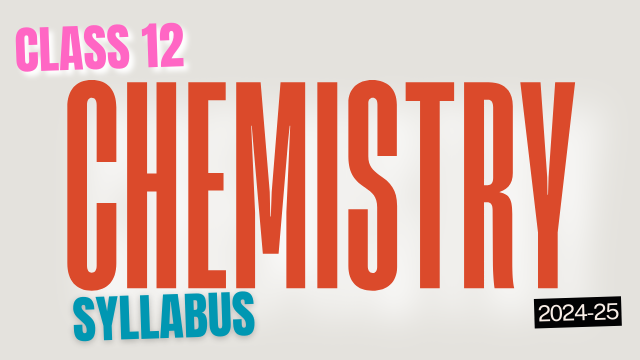The Central Board of Secondary Education (CBSE) has recently unveiled the Senior Secondary (Class 12) Chemistry syllabus for the academic session 2024-25. Below, you’ll find a comprehensive overview of the syllabus structure, including topics and examination patterns outlined by CBSE for Class 12 Chemistry.
[btn_block id=341]
CBSE Class 12 Chemistry Syllabus 2024-25
For easy access, we’ve provided the link to download the CBSE Class 12 Chemistry Syllabus PDF at the end of this article. This syllabus encompasses the entire curriculum, including details on course content, question paper design, practical assessment, and evaluation criteria.
CBSE Class 12 Chemistry 2024-25 Course Structure
The Class 12 Chemistry syllabus comprises ten units, each covering essential concepts and topics. Here’s a breakdown of the units along with the number of periods and marks allocated to each chapter:
| S.No. | Title | No. of Periods | Marks |
|---|---|---|---|
| 1. | Solutions | 10 | 7 |
| 2. | Electrochemistry | 12 | 9 |
| 3. | Chemical Kinetics | 10 | 7 |
| 4. | d -and f -Block Elements | 12 | 7 |
| 5. | Coordination Compounds | 12 | 7 |
| 6. | Haloalkanes and Haloarenes | 10 | 6 |
| 7. | Alcohols, Phenols and Ethers | 10 | 6 |
| 8. | Aldehydes, Ketones and Carboxylic Acids | 10 | 8 |
| 9. | Amines | 10 | 6 |
| 10. | Biomolecules | 12 | 7 |
| Total | 70 |
CBSE Class 12 Chemistry Syllabus for 2024-25
- Unit 2: Solutions
- Types of solutions
- Expression of concentration
- Solubility of gases in liquids
- Raoult’s law
- Colligative properties
- Unit 3: Electrochemistry
- Redox reactions
- EMF of a cell
- Standard electrode potential
- Nernst equation
- Conductance in electrolytic solutions
- Unit 4: Chemical Kinetics
- Rate of a reaction
- Factors affecting rate of reaction
- Rate law and specific rate constant
- Concept of collision theory
- Activation energy
- Unit 8: d and f Block Elements
- General introduction
- Electronic configuration
- Occurrence and characteristics of transition metals
- Unit 9: Coordination Compounds
- Introduction to coordination compounds
- Ligands
- IUPAC nomenclature
- Unit 10: Haloalkanes and Haloarenes
- Nomenclature
- Physical and chemical properties
- Uses and environmental effects
- Unit 11: Alcohols, Phenols and Ethers
- Nomenclature
- Methods of preparation
- Physical and chemical properties
- Unit 12: Aldehydes, Ketones and Carboxylic Acids
- Nomenclature
- Methods of preparation
- Mechanism of nucleophilic addition
- Unit 13: Amines
- Nomenclature
- Classification
- Methods of preparation
- Unit 14: Biomolecules
- Carbohydrates
- Proteins
- Vitamins
- Nucleic Acids
Question Paper Design 2024-25
The CBSE Class 12 Chemistry question paper is structured to assess various cognitive levels, including Remembering and Understanding, Applying, and Analysing, Evaluating, and Creating. Here’s the distribution of marks and percentages:
| S. No. | Domains | Total Marks | Percentage |
|---|---|---|---|
| 1. | Remembering and Understanding | 28 | 40 |
| 2. | Applying | 21 | 30 |
| 3. | Analysing, Evaluating and Creating | 21 | 30 |
Practical Evaluation Scheme
The practical examination for Class 12 Chemistry carries a total of 30 marks and is divided into various components:
- Volumetric Analysis
- Salt Analysis
- Content-Based Experiment
- Project Work
- Class Record and Viva
Prescribed Books
Students are advised to refer to the following NCERT publications for Class 12 Chemistry:
- Chemistry Part -I
- Chemistry Part -II
CBSE Class 12 Chemistry Syllabus 2024-25 PDF Download
Download the CBSE Class 12 Chemistry syllabus PDF for the academic session 2024-25 here. Stay updated with the latest curriculum and examination patterns to excel in your studies.



![100% Working PW MOD APK & Study Rays APK Download – [v1.5] Latest Version](https://studyratna.co/wp-content/uploads/2025/05/maxresdefault-1.jpg)




